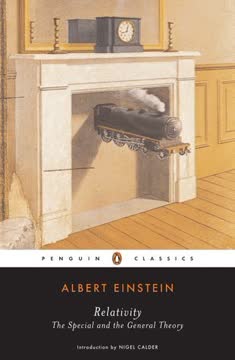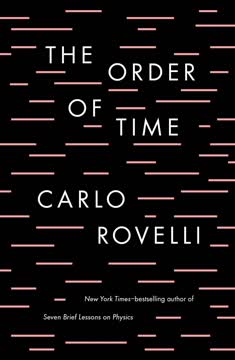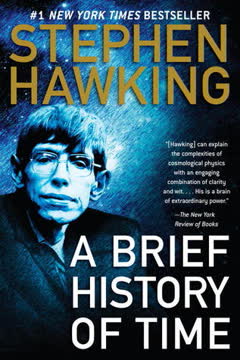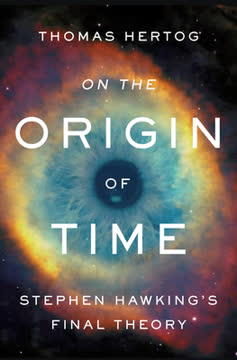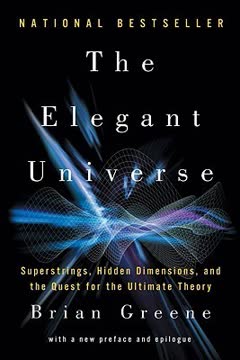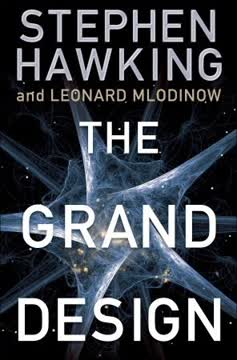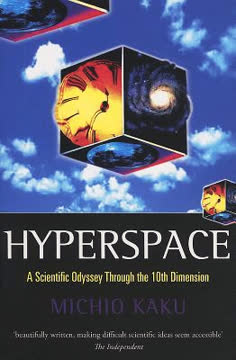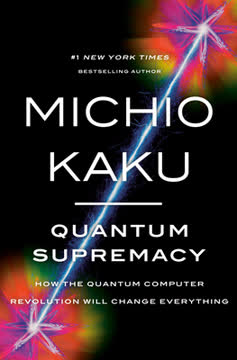Puntos clave
1. La búsqueda de una teoría unificada de todo ha impulsado la física durante siglos
"Se suponía que sería la teoría final, un marco único que uniría todas las fuerzas del cosmos y coreografiaría todo, desde el movimiento del universo en expansión hasta la danza más diminuta de las partículas subatómicas."
Contexto histórico. La búsqueda de una teoría unificada se remonta a la antigua Grecia, donde los filósofos intentaban explicar el mundo a través de elementos fundamentales. Esta búsqueda continuó con las leyes del movimiento y la gravedad de Newton, que sentaron las bases para la Revolución Industrial. El siglo XIX vio a Maxwell unificar la electricidad y el magnetismo, lo que condujo a la era eléctrica.
Desarrollos modernos. El siglo XX trajo dos teorías revolucionarias:
- La relatividad de Einstein, que explica la gravedad y el cosmos
- La mecánica cuántica, que describe el mundo subatómico
Estas teorías, aunque increíblemente exitosas en sus dominios, siguen siendo incompatibles. El santo grial de la física es encontrar una teoría única que unifique las cuatro fuerzas fundamentales: gravedad, electromagnetismo, la fuerza nuclear fuerte y la fuerza nuclear débil.
2. Las teorías de la relatividad de Einstein revolucionaron nuestra comprensión del espacio, el tiempo y la gravedad
"Para Einstein, sin embargo, el tiempo era más como un río. Podía acelerarse o ralentizarse mientras serpenteaba a través de estrellas y galaxias."
Relatividad especial. La teoría de 1905 de Einstein mostró que:
- La velocidad de la luz es constante para todos los observadores
- El tiempo se ralentiza para los objetos que se mueven a altas velocidades
- La masa y la energía son equivalentes (E = mc²)
Relatividad general. En 1915, Einstein extendió su teoría para incluir la gravedad:
- La gravedad es la curvatura del espacio-tiempo causada por objetos masivos
- Esto explica fenómenos como:
- La desviación de la luz alrededor de las estrellas
- La precesión de la órbita de Mercurio
- La existencia de agujeros negros
La relatividad general ha sido confirmada por numerosas observaciones, incluida la detección de ondas gravitacionales en 2015.
3. La mecánica cuántica reveló la naturaleza probabilística de las partículas subatómicas
"Einstein escribió que 'cuanto más exitosa se vuelve la teoría cuántica, más ridícula parece'."
Principios fundamentales. La mecánica cuántica, desarrollada en la década de 1920, describe el comportamiento de la materia y la energía a escalas atómicas y subatómicas:
- Las partículas pueden existir en múltiples estados simultáneamente (superposición)
- El acto de medir afecta el resultado (efecto del observador)
- Las partículas pueden estar entrelazadas, influyéndose mutuamente instantáneamente a través de distancias
Implicaciones filosóficas. Estos principios desafían nuestra comprensión intuitiva de la realidad:
- ¿Es el universo fundamentalmente probabilístico?
- ¿Juega la conciencia un papel en la configuración de la realidad?
- ¿Existen múltiples universos donde ocurren todos los resultados posibles?
A pesar de su naturaleza contraintuitiva, la mecánica cuántica ha sido increíblemente exitosa en explicar fenómenos y habilitar tecnologías como los láseres y los transistores.
4. El Modelo Estándar unifica tres de las cuatro fuerzas fundamentales, pero la gravedad sigue siendo esquiva
"Así, gradualmente, una nueva teoría estaba emergiendo de todo este caos, llamada el Modelo Estándar."
Componentes. El Modelo Estándar, desarrollado en la década de 1970, describe todas las partículas elementales conocidas y tres de las cuatro fuerzas fundamentales:
- Partículas:
- Quarks (6 tipos)
- Leptones (incluyendo electrones y neutrinos)
- Bosones (partículas portadoras de fuerza)
- Fuerzas:
- Fuerza nuclear fuerte (une quarks)
- Fuerza nuclear débil (desintegración radiactiva)
- Fuerza electromagnética
Éxitos y limitaciones. El Modelo Estándar:
- Predice con precisión las interacciones de partículas
- Condujo al descubrimiento del bosón de Higgs en 2012
- No incluye la gravedad
- Requiere muchos parámetros arbitrarios
- No puede explicar la materia oscura o la energía oscura
5. La teoría de cuerdas propone un nuevo marco radical para unificar todas las fuerzas y partículas
"La teoría de cuerdas era como un pozo de petróleo que de repente brotaba un torrente de nuevas ecuaciones."
Concepto central. La teoría de cuerdas propone que todas las partículas y fuerzas son en realidad vibraciones de diminutas cuerdas unidimensionales:
- Diferentes modos de vibración corresponden a diferentes partículas
- Requiere 10 o 11 dimensiones (la mayoría están "enrolladas" e invisibles)
- Incluye naturalmente la gravedad, a diferencia del Modelo Estándar
Desafíos. A pesar de su elegancia, la teoría de cuerdas enfrenta obstáculos significativos:
- Aún no hay evidencia experimental
- Se requieren energías extremadamente altas para pruebas directas
- Múltiples versiones de la teoría (unificadas por la teoría M)
- Predice un vasto "paisaje" de posibles universos
La teoría de cuerdas sigue siendo altamente controvertida, con críticos que argumentan que es imposible de probar y defensores que creen que es el camino más prometedor hacia una teoría unificada.
6. La teoría del todo podría explicar los orígenes y el destino del universo mismo
"Quizás nuestro universo se originó a partir de fluctuaciones cuánticas en la Nada."
Implicaciones cosmológicas. Una verdadera teoría del todo tendría profundas consecuencias para nuestra comprensión del cosmos:
- Origen del universo:
- Explicación del Big Bang
- Posible existencia de un multiverso
- Evolución del universo:
- Inflación y expansión
- Formación de galaxias y estructura a gran escala
- Destino del universo:
- Destino final (Gran Congelación, Gran Colapso o Gran Desgarro)
- Posibilidad de universos cíclicos
Preguntas sin resolver. Misterios clave que una teoría unificada podría abordar:
- Naturaleza de la materia oscura y la energía oscura
- Existencia de otras dimensiones o universos
- Posibilidad de viajes en el tiempo o agujeros de gusano
7. Comprender el cosmos plantea preguntas profundas sobre el significado y la existencia
"La pregunta de todas las preguntas para la humanidad, el problema que yace detrás de todos los demás y es más interesante que cualquiera de ellos, es el de la determinación del lugar del hombre en la Naturaleza y su relación con el Cosmos."
Implicaciones filosóficas. La búsqueda de una teoría del todo inevitablemente conduce a profundas preguntas existenciales:
- ¿Tiene el universo un propósito o diseño?
- ¿Hay un papel para un creador o Dios en el cosmos?
- ¿Cómo encontramos significado en un universo potencialmente finito?
Perspectiva científica. Aunque la ciencia no puede responder directamente a estas preguntas, proporciona un marco para la contemplación:
- El principio antrópico sugiere que nuestro universo está afinado para la vida
- La teoría del multiverso propone innumerables universos con diferentes propiedades
- La vastedad y belleza del cosmos inspiran asombro y maravilla
En última instancia, la búsqueda de una teoría unificada no se trata solo de comprender el mundo físico, sino de nuestro lugar dentro de él y la naturaleza misma de la existencia.
Última actualización:
FAQ
What's "The God Equation: The Quest for a Theory of Everything" about?
- Unified Theory Goal: The book explores the quest for a single framework that unites all the forces of the universe, from the motion of galaxies to subatomic particles.
- Historical Journey: It traces the history of physics, from ancient dreams of unification to modern string theory, highlighting key scientific revolutions.
- String Theory Focus: The narrative centers on string theory as the leading candidate for a theory of everything, explaining its potential to unify gravity with quantum mechanics.
- Philosophical Implications: The book also delves into the philosophical questions about the universe's origin, structure, and meaning.
Why should I read "The God Equation: The Quest for a Theory of Everything"?
- Comprehensive Overview: It provides a thorough overview of the history and current state of theoretical physics, making complex ideas accessible.
- Scientific Insight: Readers gain insight into the minds of great physicists like Einstein and Hawking and their contributions to the quest for unification.
- Philosophical Exploration: The book addresses profound questions about the universe's purpose and the existence of a grand design.
- Engaging Narrative: Michio Kaku's engaging writing style makes the intricate world of physics both understandable and fascinating.
What are the key takeaways of "The God Equation: The Quest for a Theory of Everything"?
- Unification Dream: The pursuit of a unified theory has been a long-standing goal in physics, aiming to explain all natural forces with a single equation.
- String Theory's Role: String theory is currently the most promising candidate for a theory of everything, proposing that the universe is made of tiny vibrating strings.
- Challenges and Criticisms: Despite its potential, string theory faces significant challenges, including lack of experimental evidence and the landscape problem.
- Philosophical Questions: The book raises questions about the universe's origin, the possibility of a multiverse, and the role of a creator or grand design.
How does Michio Kaku explain string theory in "The God Equation"?
- Vibrating Strings Concept: Kaku explains that string theory posits the universe is composed of tiny, vibrating strings, with each vibration corresponding to a different particle.
- Dimensionality: The theory suggests that the universe has ten dimensions, with six of them curled up and unobservable at our scale.
- Inclusion of Gravity: Unlike other theories, string theory naturally includes gravity, making it a strong candidate for unifying all forces.
- Supersymmetry: The theory incorporates supersymmetry, which posits a symmetry between particles that make up matter and those that mediate forces.
What are the main criticisms of string theory according to "The God Equation"?
- Lack of Testability: Critics argue that string theory is difficult to test experimentally, as it requires energies far beyond current capabilities.
- Infinite Solutions: The theory predicts a multiverse with an infinite number of solutions, making it hard to determine which one describes our universe.
- Complexity and Elegance: While mathematically elegant, some physicists question whether beauty alone is a reliable guide in physics.
- Anthropic Principle: The reliance on the anthropic principle to explain why our universe is special is seen as unsatisfactory by some scientists.
What is the significance of the "God Equation" in Michio Kaku's book?
- Ultimate Goal: The "God Equation" refers to the ultimate equation that would unify all physical laws, explaining everything from the Big Bang to subatomic particles.
- Einstein's Dream: It represents the culmination of Einstein's quest for a unified field theory, a pursuit that has driven physicists for over a century.
- String Theory's Promise: String theory is seen as the closest approach to achieving this equation, with its potential to unify gravity and quantum mechanics.
- Philosophical Implications: The equation raises questions about the universe's design, purpose, and the existence of a creator.
How does "The God Equation" address the concept of a multiverse?
- Inflation Theory: The book discusses how inflation theory suggests our universe is one of many bubbles in a larger multiverse.
- String Theory's Landscape: String theory's landscape problem implies an infinite number of possible universes, each with different physical laws.
- Philosophical Questions: The multiverse concept challenges traditional notions of a single, unique universe, raising questions about our place in the cosmos.
- Anthropic Principle: The existence of a multiverse is used to explain why our universe appears fine-tuned for life, as we exist in one of the few universes where life is possible.
What are the best quotes from "The God Equation" and what do they mean?
- "The universe is a symphony of strings." This quote encapsulates the essence of string theory, suggesting that all particles and forces are manifestations of vibrating strings.
- "Did God have a choice in creating the universe?" This question, posed by Einstein, reflects the search for a unique, inevitable set of physical laws governing the universe.
- "Sometimes God throws the die where you cannot find them." Hawking's quote highlights the uncertainty and unpredictability inherent in quantum mechanics, especially in black holes.
- "Beauty is truth, truth beauty." This Keats-inspired sentiment underscores the belief that the universe's fundamental laws are both beautiful and true, guiding physicists in their quest.
How does Michio Kaku address the philosophical implications of a theory of everything?
- Existence of God: Kaku explores whether a theory of everything implies a grand design or creator, considering both scientific and theological perspectives.
- Meaning of Life: The book raises questions about whether understanding the universe's fundamental laws can provide insight into life's purpose and meaning.
- Human Understanding: Kaku suggests that a complete theory should be understandable by everyone, allowing all to participate in discussions about existence.
- Limitations of Science: He acknowledges that some questions, like the origin of the laws themselves, may remain beyond the reach of science, entering the realm of metaphysics.
What role does symmetry play in "The God Equation"?
- Unifying Principle: Symmetry is a central theme, seen as the key to unifying all forces and particles in the universe.
- Predictive Power: Symmetry helps predict new particles and phenomena, as seen in the discovery of antimatter and quarks.
- Eliminating Infinities: In string theory, supersymmetry helps cancel out infinities that plague other quantum theories, making it a candidate for a finite theory of gravity.
- Aesthetic Appeal: Symmetry is also associated with beauty in physics, guiding the search for elegant and simple explanations of complex phenomena.
How does "The God Equation" explain the relationship between quantum mechanics and general relativity?
- Conflicting Theories: The book highlights the fundamental conflict between quantum mechanics, which governs the small, and general relativity, which governs the large.
- String Theory's Promise: String theory offers a framework to reconcile these two theories by describing particles as strings, naturally incorporating gravity.
- Quantum Gravity: The quest for a theory of quantum gravity aims to unify these theories, explaining phenomena like black holes and the Big Bang.
- Experimental Challenges: Despite theoretical progress, testing the unification of these theories remains a significant challenge due to the high energies required.
What is Michio Kaku's perspective on the future of string theory?
- Ongoing Evolution: Kaku believes string theory is still evolving, with new mathematical layers being uncovered, suggesting it is not yet in its final form.
- Mathematical Consistency: He argues that the theory's ultimate validation may come from its mathematical consistency and ability to derive known physical constants.
- Experimental Hopes: While direct experimental evidence is challenging, Kaku remains hopeful that future discoveries, like dark matter or mini black holes, may support the theory.
- Patience Required: He emphasizes that scientific progress can be slow, and the ultimate understanding of string theory may take time, much like past scientific revolutions.
Reseñas
La ecuación de Dios recibe críticas mixtas, con elogios por su accesible resumen de la historia de la física y la teoría de cuerdas, pero críticas por su brevedad y falta de profundidad. Algunos lectores aprecian las claras explicaciones y reflexiones filosóficas de Kaku, mientras que otros encuentran el contenido superficial y engañoso. El uso de "Dios" en el título es controvertido. Los críticos señalan que gran parte del material es familiar de otros libros populares de física, con limitadas nuevas perspectivas. Los capítulos finales sobre la teoría de cuerdas y sus implicaciones se consideran los más interesantes, aunque demasiado breves.
Similar Books
